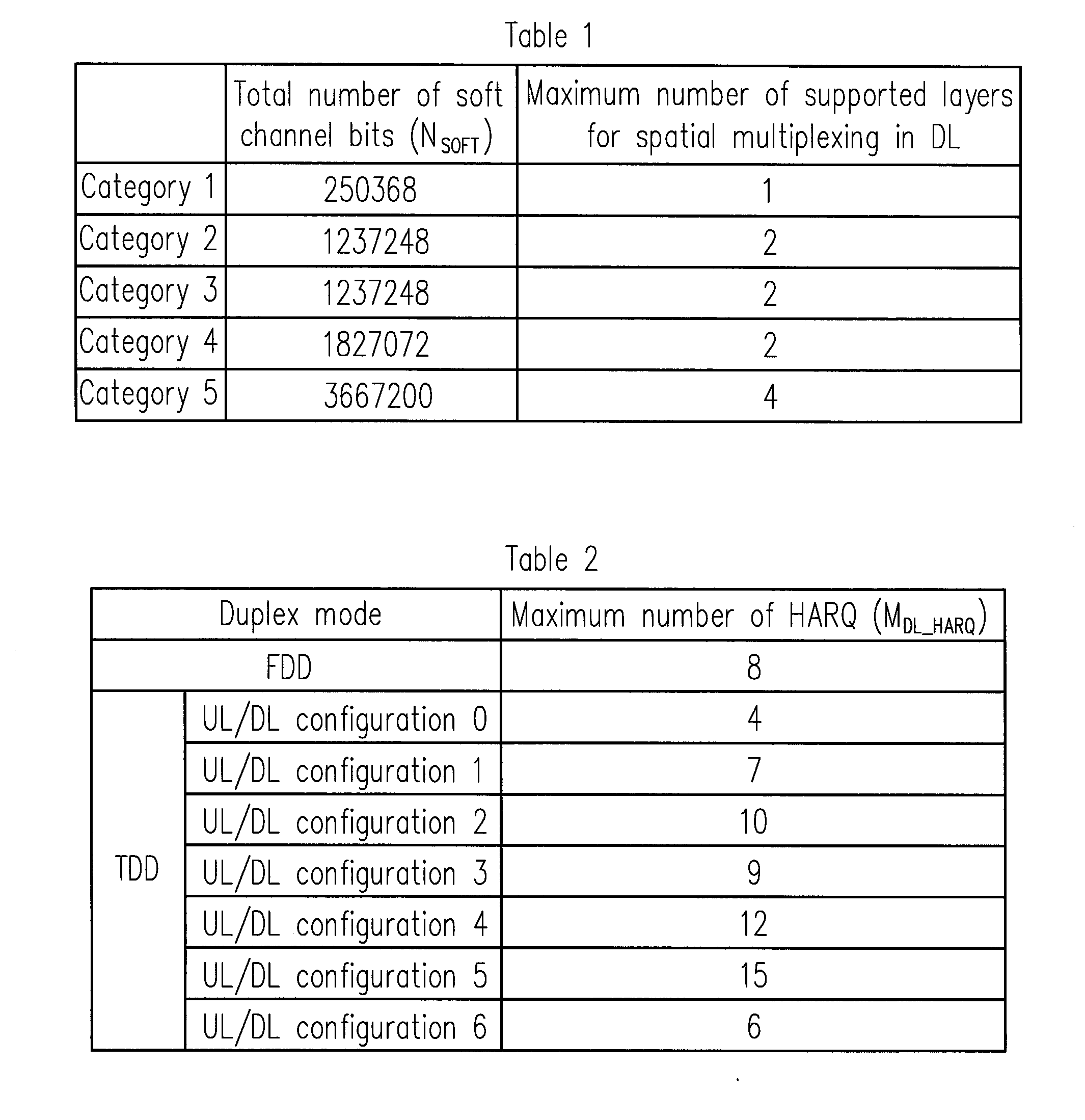Method and apparatus for soft buffer partitioning in time-division duplexing system
a time-division duplex and soft buffer technology, applied in electrical equipment, digital transmission, error prevention, etc., can solve the problem that ue may need to store multiple harq processes
- Summary
- Abstract
- Description
- Claims
- Application Information
AI Technical Summary
Benefits of technology
Problems solved by technology
Method used
Image
Examples
first embodiment
[0048]In the disclosure hereafter, methods and apparatuses for partitioning the soft buffer are described with reference to the accompanying figures, in which the same reference numerals are used for the same components. According to some embodiments of the disclosure, each serving cell has a dedicated sub-block. In a first embodiment, a method for partitioning the soft buffer in the TDD system is introduced as follows. The total number of soft channel bits, Nsoft, depends on the category of the UE. Nsoft can be divided into multiple partitions according to the following equation:
NIR=⌊NsoftKMIMO·∑i=1NCmin(MDL_HARQ(i),Mlimit)⌋(2)
[0049]where NIR is a size of a partition used for storing a transport block of each serving cell. NC is the number of configured serving cell to the UE. Nsoft is the total number of soft channel bits of the UE. KMIMO is a maximum number of transport blocks that may be transmitted to the UE in a TTI. Further, the value of KMIMO might be cell-specific, in this ...
second embodiment
[0051]According to the disclosure, the preconfigured maximum number of HARQ processes, or Mlimit, is infinity. A method for partitioning the soft buffer in the TDD system is introduced as follows. The total number of soft channel bits, Nsoft, depends on the category of the UE. Nsoft can be divided into multiple partitions according to the following equation:
NIR=⌊NsoftKMIMO·∑i=1NCMDL_HARQ(i)⌋(3)
[0052]where NIR is a size of a partition used for storing a transport block. NC is the number of configured serving cells to the UE. Nsoft is the total number of soft channel bits of the UE. KMIMO is a maximum number of transport blocks that may be transmitted to the UE in a TTI. Further, the value of KMIMO might be cell-specific, in this case, KMIMO is equal to KMIMO(i) for the i-th serving cell. MDL—HARQ(i) is a maximum number of DL HARQ processes of the i-th serving cell, and related to its UL-DL configuration where 1≦i≦NC, i being a positive integer.
[0053]FIG. 7 is a schematic view of a so...
third embodiment
[0054]According to the disclosure, a method for partitioning the soft buffer in the TDD system is introduced as follows. The total number of soft channel bits, Nsoft, depends on the category of the UE. Nsoft can be divided into multiple partitions according to the following equation:
NIR(i)=⌊Nsoft(i)KMIMO·min(MDL_HARQ(i),Mlimit)⌋wherei=1,…,NC(4)
[0055]where NIR(i) is a size of a partition used for storing a transport block of the i-th serving cell, i being a positive integer. NC is the number of serving cells to the UE. Nsoft(i) is the number of soft channel bits of the i-th serving cell of the UE and the value of Nsoft(i) is configured by higher-layer signalling or determined by a predefined function. KMIMO is a maximum number of transport blocks that may be transmitted to the UE in a TTI. Further, the value of KMIMO might be cell-specific, in this case, KMIMO is equal to KMIMO(i) for the i-th serving cell. Mlimit is a positive value. MDL—HARQ(i) is a maximum number of DL HARQ proces...
PUM
 Login to View More
Login to View More Abstract
Description
Claims
Application Information
 Login to View More
Login to View More - R&D
- Intellectual Property
- Life Sciences
- Materials
- Tech Scout
- Unparalleled Data Quality
- Higher Quality Content
- 60% Fewer Hallucinations
Browse by: Latest US Patents, China's latest patents, Technical Efficacy Thesaurus, Application Domain, Technology Topic, Popular Technical Reports.
© 2025 PatSnap. All rights reserved.Legal|Privacy policy|Modern Slavery Act Transparency Statement|Sitemap|About US| Contact US: help@patsnap.com



